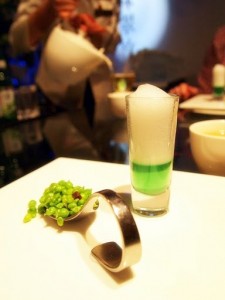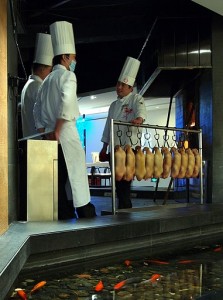
Chain restaurants occupy a very different place in the foodie ecosystem in China. Here in the West, chains tend to be reliably mediocre (or worse), only worth visiting if you’re away from home and have a particular hankering for that very specific and very homogeneous pizza/burger/pasta thing that they do in the branch round the corner from your house.
In China, though, you’ll find chains (smaller than your average UK effort, but chains nonetheless) like Da Dong Roast Duck and Nan Xiang dumplings (more on them later this week) where the number of branches is an advertisement for the popularity and excellence of the cooking, not a sign of bland uniformity. Several people had suggested Da Dong to me (I’m afraid there’s no English website), so I asked the hotel concierge which branch he recommended, and ended up at the newest, at Jinbao Place in the Dongcheng district.
Jinbao Place is one of those glistening, insanely swanky shopping malls, all Gucci and Burberry, where an emergency shirt to replace the one you’ve spilled hot and sour soup down just before a meeting (this actually happened to one of the people we were travelling with) will cost you RMB 2000, or £200. The whole of the fourth floor is taken up by Da Dong, with its koi stream running through the restaurant, around an open duck prep area; its Scandinavian-style interior decorations; and an awful lot of polished black granite. Despite all the gloss, we only paid RMB 600 (£60) for a battleship-sinking amount of food and an awful lot of beer – this is pricey for Beijing, but the food is so much more interesting than anything you’ll find at home, I’m sure you can wear it.
Menus are printed in English. There’s a very expensive seafood section full of abalone, lobster, sea cucumber and other premium ingredients, where exquisitely photographed pictures of each dish accompany each description, alongside a much more affordable section of traditional Beijing dishes, without photos. We ordered mostly from the non-photo section – and we steered clear of the oxtail soup with a dirty great seahorse (a creature on the Red List of endangered species) bobbing up and down in it. A colleague did order a seahorse by accident at another restaurant without an English menu, and said it was a lot like eating an ear.
At the moment, Euro/American molecular techniques are pretty fashionable in Beijing, so our little starter plates of wind dried ham with tiny sweet peas, quite different from a Western pea with their thin skins and intense sugary flavour, came delicately arranged on a spoon, all accompanied by a frothy little shot glass of something that appeared to be minty mouthwash. A palate cleanser? Whatever it was meant to be, it was a little alarming and a very curious choice of flavour next to those glorious little peas, but it was oh-so-pretty that I feel like letting them off. You can just make out some tea being poured in the background – there’s a long and involved tea menu, and it’s well worth your while exploring something other than the bog-standard jasmine tea.
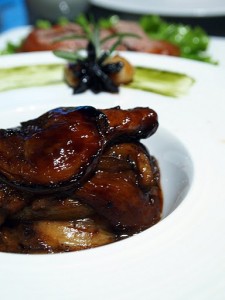
Some peeled prawns, deep-fried in batter then simmered in a garlicky sauce, which was soaked up by the softened batter, were curious texture-wise, but that limp batter created an incredible vehicle for the flavour of the sauce. A Kilner jar of pork chops, cooked according to a “mystery technique”, was threaded through with sugar cane and grilled over charcoal, then snipped into bite-sized bits with scissors at the table – and was so heavy on the MSG that we got through our glasses of beer very quickly, and needed a top-up for the teapot. Add a really superb braised aubergine, gorgeously dense with thick, sweet soy and aromatic with anise and garlic; and a dish of gai lan (mustard greens) stir-fried with ginger, and we were pretty much full – but it remains my firm belief that everybody has a separate stomach for dessert, and it’s my enormous genetic good luck to be blessed with yet another stomach just for roast duck in pancakes. (I managed to put weight on at a rate of about a pound a day while we were in China, and spent the next week in Hungary – long story – running up and down hills to try to burn it all off, so be warned: gorging yourself like this doesn’t come without consequences.)
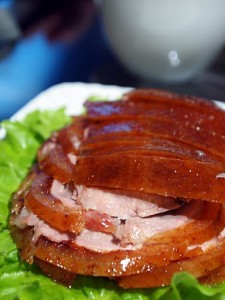
The duck at Da Dong is the main event. They claim to have invented a technique whereby the duck is much leaner than other Beijing roast ducks – the skin here is popcorn-puffy and exceptionally crisp and dry, while the flesh remains moist and juicy. Peering into the dark duck prep area, which was manned by chefs in toques and anti-sneeze facemasks (see the picture at the top of the page), I could make out that the ducks were being steamed or boiled in a purpose-built-something that looked like a small well in the middle of the room, then hung on racks before being cooked until a glorious gold in wood-fired ovens.
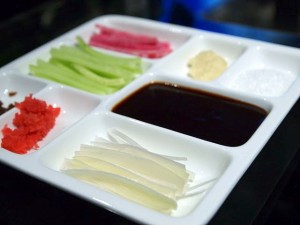
The duck is carved tableside, and you’re given the halved head (full of curdy brains and covered with crisp skin), sans beak, to chew and suck on – which I did, to Dr W’s great displeasure. Your first pancake is assembled for you, after which you’re left on your own with a heap of pancakes, two little pitta-ish buns, and dish of condiments – sugar, a duck sauce, pickled ginger, pickled vegetables, crushed garlic, spring onions, radish and cucumbers. You can do what you like with these, but do try a sliver of skin dipped into the granulated sugar – surprisingly, abominably good. A pallid soup also accompanies the duck, but it’s eminently missable. This wasn’t the only Beijing roast duck I ate in our week in China, and there’s definitely something to that technique – the duck is much less fatty and exceptionally crisp, which appears to be more palatable to Western tastes. The accompanying duck sauce wasn’t the best I’ve had – full-on sweet, a little bitter and without the fragrance of fermented soy and rice wine I’d been hoping for – but this seems a minor quibble alongside that shatteringly crisp skin.
A complementary fruit plate arrives at the end to cleanse you of ducky thoughts. It sits on top of a gushing dish of dry ice, which doesn’t make it taste any nicer, but is awfully good fun to look at.
Once we’d finished looking at fruit, we waddled, duck-wise, down past the shops full of diamonds and branded leather and collapsed into a taxi. A great evening, but given my waistline, it’s a restaurant I’m glad that I have to travel 11 hours to get to. One of the branches of Da Dong is definitely worth the visit if you’re in the city.

